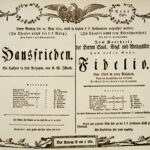In this article we take a short journey in the history of opera discovering the roots and the development of this art form.
Opera in Italy
The word opera comes from the Italian phrase opera in musica – work in music. The name represents all the efforts that build up an opera. The text (libretto, booklet), the music itself, the choral singers, the stage, costumes and movements.
Root of any musical drama is coming from the ancient Greek dramatists. Later, during the Middle Ages, Biblical stories were chanted and performed. The real modern opera however was born in North-Italy, in Florence. This city had everything ready and in place for giving birth to this new genre: strong theatrical tradition, a hint of humanism and a special view of music as a force of and link to the Universe.
Opera quickly became popular spreading to other important cities like Mantua, Venice, Naples or Rome. The role of Venice in the development of opera, similar to Florence, is outstanding! In 1637 the first opera house, the Teatro di San Cassiano, was opened and financed by the wealthy families of the city. This event removed the opera from the domains and patronage of the nobility making it available for the citizens. At the end of the century Venice had nine such commercial theaters!
All cities had something unique to add bringing many different operatic styles to life.
The German opera
Opera on German speaking areas appeared after Italian opera composers visited or resided in their cities. In fact, Italy’s influence was so strong that for a century even German composers used both Italian opera style and language. The first known German language opera was Dafne by Heinrich Schütz, in 1627. A dedicated German word was used for such performances, Singspiel.
Viennese audience was attracted to the Italian opera and later the opera buffa (comic opera) and local musicians followed suit. Haydn created music for 20 plays from short operas for marionettes, to opera buffas. The real heavy weight of the Vienna opera scene was Mozart.
His first theatrical music composition was done at age 10 and by 25 he completed his first opera Idomeneo, in Munich. Just a year later he rolled out The Abduction from the Seraglio and a few years later The marriage of Figaro, followed by Don Giovanni and the Magic flute.
After Mozart, the emptiness he left behind in German opera, was not filled for many decades. Beethoven composed only one opera, Fidelio, and despite its success, he was never satisfied with the play. The Fidelio’s libretto was written by Joseph Sonnleithner and was on in 1805, then in a revised form in 1806 and 1814.
The German opera, after the quiet years, revives in the 1820s with the appearance of Weber and the German romanticism. Nature, the supernatural, forces bigger than the main characters are always present in these plays with the longing for the pure and idealized love.
Music, the stage and story should work together under the Wagnerian approach. He perfected the storytelling of myths and legends. His most famous German mythical work, the Ring cycle lasts about 16 hours if played without interruption. This alone shows his dedication to the genre!
The last name to mention in the golden era of German opera is Richard Strauss, who was considered as the obvious heir to Wagner. His first success in opera came with Salome and Elektra, followed by 11 more compositions. Many consider his best work to be The woman without a shadow, from 1919.



